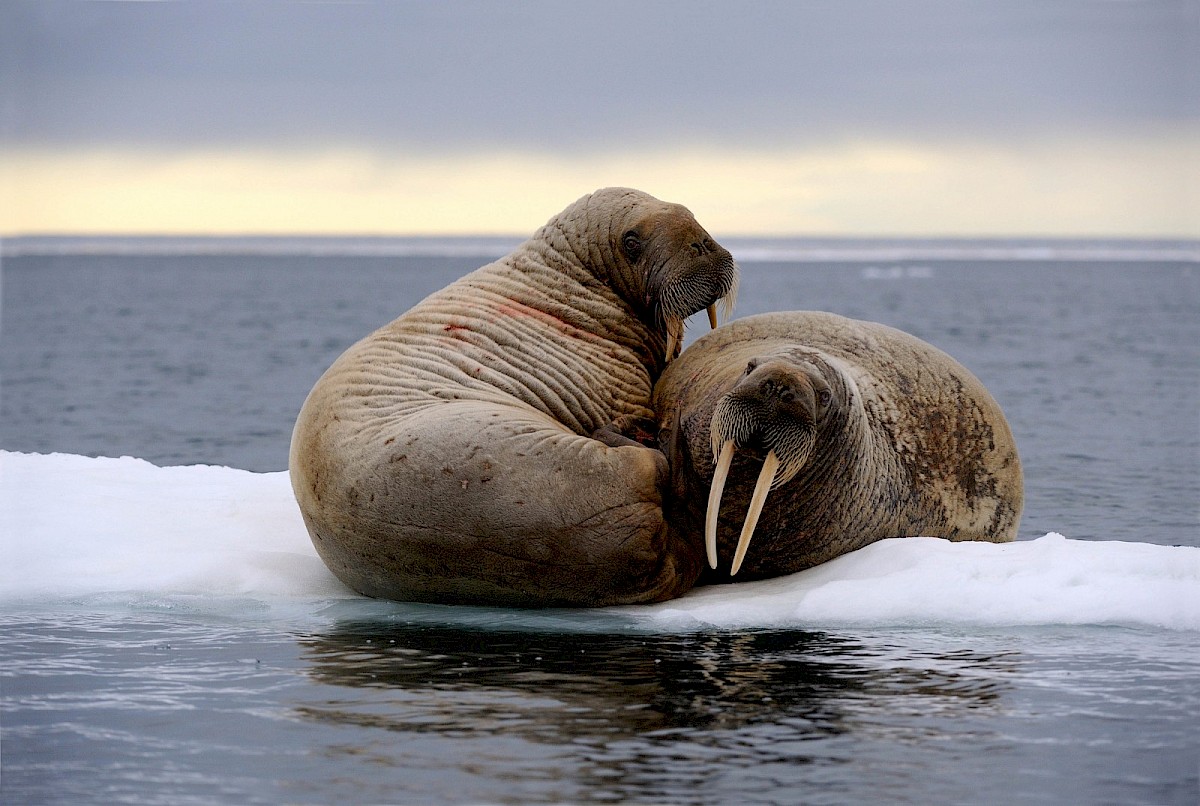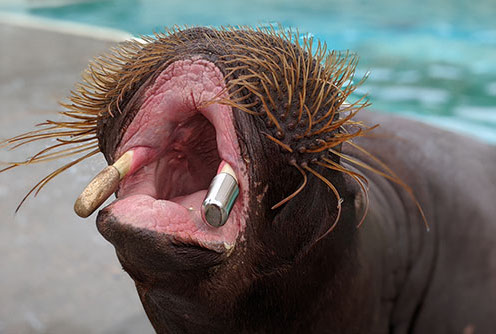Researchers from the Canadian École de Technologie Supérieure (ÉTS) and Université de Montréal have 3D printed protective ‘crowns’ for the tusks of an endangered walrus sheltered at the nearby Aquarium du Québec.
Four of the marine mammals are under conservation at the aquarium, but their new concrete habitat is not well-suited to their dental needs, as they pull themselves out of the water using their tusks. Using a 3D scanning and printing approach, the team were able to precisely fabricate metal caps that could fit the walrus’ tusks exactly, and prevent them from becoming vulnerable to dental abscesses.
“This practice [walking on their teeth] poses no problem in a natural environment made of ice and soil,” explained Dr. Claire Grosset, a Professor of Zoological Medicine at Université de Montréal. “But things are different in a habitat composed of concrete, metal and other materials selected to withstand these animals, whose weight can reach more than a tonne.”

Taking care of endangered walruses
Many Atlantic walruses, known in scientific circles as Odobenus rosmarus, used to live in Canada’s northern Arctic region, but they have been under threat of extinction for years. Having been hunted for its ivory, meat and blubber between the 17th and 19th centuries, the Atlantic walrus is now entirely extinct in the once populous areas of Newfoundland and Nova Scotia.
Oil and gas drilling is now becoming a threat to the Arctic mammals too, by reducing the amount of available sea ice, and causing stampedes among the sound and stress-sensitive animals. In order to ensure the endangered species are able to reproduce, and draw attention to their plight, the Aquarium de Québec has taken them in.
The species’ Latin name Odobenus rosmarus translates roughly into “walks on its teeth,” which is an apt description of how they hoist themselves out of the water in their natural habitat. Unfortunately, now that they’re living in the aquarium, the concrete and metal surfaces around the walrus’ enclosure could be damaging to their tusks, putting them at risk of dental abscesses.

A 3D printed approach to dental care
One of the aquarium’s 400kg four-year-old female walruses (who sadly wasn’t introduced by name), was found to be at particular risk of cracking or fracturing her tusks. To prevent any further damage from being caused to her pearly-whites, veterinary experts recommended protecting them with made-to-measure metal caps.
Deploying a crown could be considered similar to a human getting a filling, in that they help to avoid the need to remove any ‘teeth,’ which is a far more invasive procedure. What’s more, using a treatment that doesn’t require anesthesia is highly beneficial, as some sedatives can be deadly for this particular species of walrus.
Although other tusk-caps have been developed in the past, they’ve been created using conventional production processes, and the team began by assessing which metal would yield the optimal device. Eventually the researchers opted for cobalt chrome, as it would prevent repetitive rubbing, while being resistant to oxidization in salt water.

During the 3D printing process, three different caps were produced, which offered clearances of between 0.25mm and 0.45 mm to the tusk. The different size options allowed the procedure’s veterinary surgeon to choose the optimal device, that wouldn’t weaken the adhesive’s bond, or prevent it from fitting tightly to the ivory.
Given the potential effects of anesthesia on the walrus, the team decided to train the mammal to be perfectly still, avoiding the need for sedatives altogether. Over several months, the walrus was trained three or four times daily to remain immobile for increasingly long periods, and rewarded with a treat for her success.
Ultimately, the sea-faring animal managed to stay steady for five minutes straight, which allowed the veterinary expert to fit one of the 3D printed devices successfully. According to the researchers, it was a combination of the crown’s unique production process, and the bond between the mammal and her trainer, that made the overall procedure possible.
Eco-friendly additive innovations
3D printing has proved to be an effective means of wildlife preservation in a wide variety of ways in recent years.
Scientists from the University of Kent and conservation organisation Paso Pacifico, have developed 3D printed sea turtle eggs to prevent the theft and trade of the real ones in Costa Rica. The additive devices, which were nicknamed the ‘InvestEggators,’ featured GPS trackers, allowing them to be used to uncover illegal trade routes up to 137km away.
Engineers from Georgia Institute of Technology, meanwhile, have devised an innovative method of monitoring the environment at the Atlanta Botanical Garden: a 3D printed Slothbot. The robotic mammal is currently loitering in the trees above the 40-acre forest, ensuring that the temperature, weather and carbon dioxide levels there remain consistent.
Elsewhere, a team of architects at Hong Kong University (HKU) have 3D printed 128 hexagonal clay tiles and dropped them into the ocean, in an attempt to preserve a local marine park there. It’s hoped that the fabricated structures, which were seeded with popular species from the bay, will provide a new home for dislodged coral to land on.
To stay up to date with the latest 3D printing news, don’t forget to subscribe to the 3D Printing Industry newsletter or follow us on Twitter or liking our page on Facebook.
Looking for a new podcast? Be sure to subscribe to the Another Dimension podcast on your chosen podcast player to make sure you never miss an episode.
Are you looking for a job in the additive manufacturing industry? Visit 3D Printing Jobs for a selection of roles in the industry.
Featured image shows a walrus from the Aquarium du Québec with its 3D printed crowns in place. Photo via the CNW Group/École de Technologie Supérieure.



